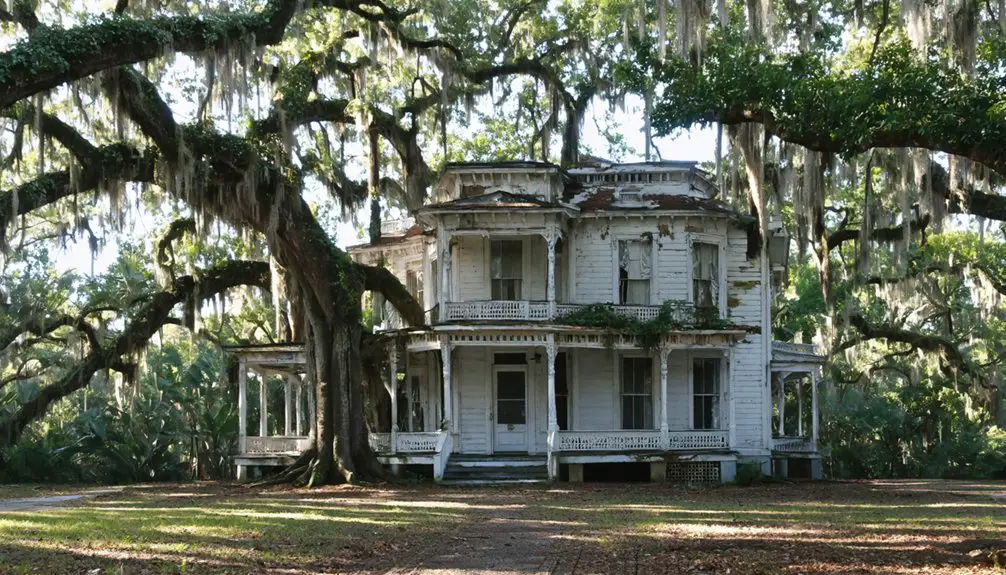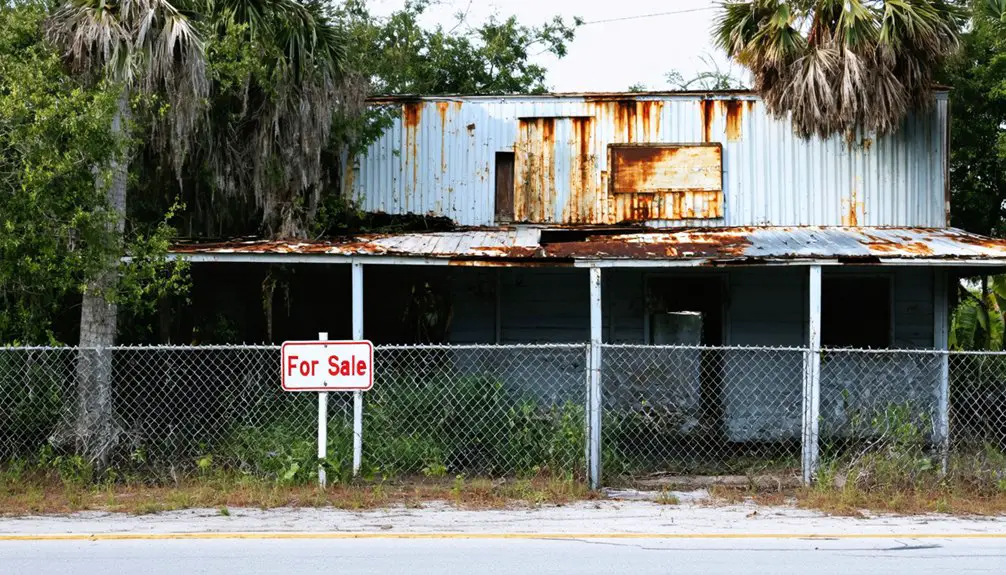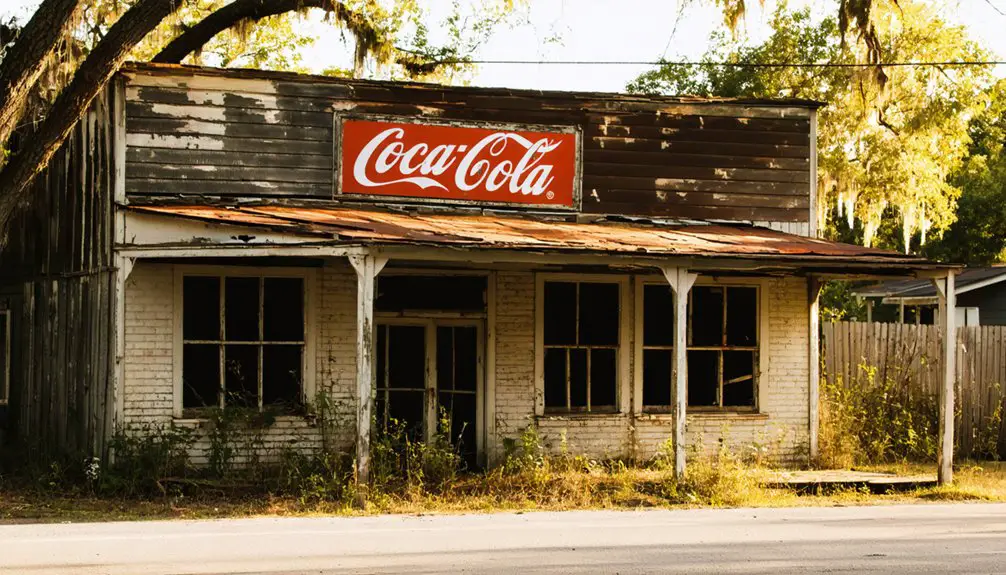You’ll find Providence’s ghost town ruins along Florida’s historic Bellamy Trail, where this once-thriving regional hub served as an essential 19th-century settlement. Originally established by pioneers from Georgia and South Carolina, Providence flourished through agriculture and trade until severe freezes in 1894-1895 devastated the farming community. Today, nature has reclaimed the abandoned buildings, post office, and Old Providence Baptist Church, with only crumbling headstones and scattered artifacts marking its remarkable pioneer legacy. The site’s hidden stories await beneath the vines and underbrush.
Key Takeaways
- Providence was a thriving 19th-century North Florida settlement that served as county seat for Columbia, Bradford, and Union Counties.
- The town’s economic decline began with devastating freezes in 1894-1895 that destroyed agricultural prosperity and led to widespread abandonment.
- The closure of the post office marked a critical turning point, causing residents to relocate and seek opportunities elsewhere.
- Hurricane Helene and economic collapse in 2025 dealt the final blow, with property values plummeting and insurance costs rising 52%.
- Nature has completely reclaimed the ghost town, with its cemetery, buildings, and streets now hidden beneath vines and underbrush.
Early Pioneer Settlement Origins
While Spanish explorers first encountered the Providence area during Hernando De Soto’s 1539 expedition, permanent settlement didn’t begin until the late 18th century when pioneers from Georgia and South Carolina established plantations in the region.
Much like the stone quarry workers in Rhode Island’s Hanton City, early settlers like Daniel Stewart, who cultivated Sea Island cotton by 1790, laid the foundation for pioneer agriculture that would define the area’s economy.
The Spanish had previously established the Catalina De Ajomica mission to evangelize Timucuan Indians in the early 1600s, but English forces destroyed it in 1702.
After this tumultuous period, the region remained largely unsettled until hardy pioneers transformed the landscape through plantation agriculture.
During the Seminole Indian Wars of 1835-42, settlers sought protection in nearby fortifications within a four-mile radius of Providence.
You’ll find that these early settlers’ agricultural focus, particularly on cotton and orange groves, created a stable farming community that would attract more settlers in the decades to come.
The Rise as a Regional Hub
Although Providence never grew into a major city, it emerged as an essential regional hub in North Florida during the early 1800s. You’ll find evidence of its regional significance in the early establishment of a U.S. Post Office and its role as county seat for a vast territory encompassing present-day Columbia, Bradford, and Union Counties.
The settlement’s strategic location along the Bellamy Trail positioned it within critical communication networks. You could access Providence through multiple transportation routes, including steamer services and 2WD roads connecting to neighboring communities. With keyboard shortcuts available, residents could efficiently navigate between different areas of the settlement. Like many Florida settlements, Providence faced the constant challenge of natural encroachment as vegetation and wildlife threatened to reclaim cleared areas.
The village supported a thriving agricultural community with its exceptional farming conditions, while its commercial district featured drug stores, mercantile establishments, and blacksmith shops. These services, combined with government weather stations and telegraph lines, cemented Providence’s position as a vital administrative and trade center.
Life in 19th Century Providence
Despite its modest size, Providence showcased a vibrant social tapestry in the 19th century, where you’d find merchants, skilled artisans, farmers, and laborers coexisting in a dynamic community.
You’d witness the pulse of democracy at town meetings, where community gatherings shaped local governance and daily life. The social hierarchy was evident in the town’s architecture, from simple wooden dwellings to grand brick homes of wealthy merchants.
Your daily life would revolve around the bustling port, where ships brought global trade to local wharves. You’d find work in shipyards, ropewalks, or distilleries, while markets served as hubs for commerce and news exchange. Residents could fill prescriptions and seek medical care at the town’s two local drugstores.
Churches stood as pillars of social life, influencing community norms and activities, while schools gradually emerged to advance education.
Agricultural Heritage and Economy
As one of Florida’s finest farming regions, Providence emerged as a closely settled village where rich agricultural land supported diverse cultivation. Similar to nearby communities like pineapple plantations that flourished in the late 1800s, these farms represented significant agricultural enterprise.
You’ll find evidence of significant crop diversity through the remnants of corn cribs, cotton fields, and citrus groves that once sustained the local economy. Similar to stagecoach road travel established in nearby Kerr City during the 1860s, the village’s agricultural resilience initially thrived due to its strategic location along stagecoach routes like the Bellamy Trail, enabling farmers to transport their harvests to market.
However, Providence’s dependence on vulnerable crops proved devastating when severe freezes struck in 1894-1895. Without sufficient economic diversification, the farming community couldn’t recover from these crop failures.
As transportation shifted to railroads and agricultural opportunities dwindled, families abandoned their homesteads, leaving only traces of their once-prosperous farming heritage.
Key Historical Landmarks and Routes
Along the historic Bellamy Trail, you’ll find the weathered remains of Providence’s most significant landmarks, including the Old Providence Baptist Church foundation stones that marked the town’s spiritual center. Similar to the dark colonial past that haunts present-day Providence, Rhode Island, this Florida ghost town holds many untold stories in its ruins. Like preserved architecture in Virginia City, these structures offer insights into early Florida frontier life.
The early post office location, identifiable by its distinctive stone foundation pattern and surviving postal records from 1821-1839, served as a crucial communication hub for the growing settlement.
These landmarks formed a triangle of civic life along what was once north Florida’s major thoroughfare between St. Augustine and Pensacola, where stagecoaches and traders regularly traveled before the town’s decline.
Bellamy Trail Historic Path
The historic Bellamy Trail represents one of Florida’s most significant early transportation routes, following an ancient Spanish path that connected Santa Fe Lake to the natural bridge spanning the Santa Fe River.
You’ll find the trail’s origins tied to John Bellamy, who stayed with pioneer Simeon Dell in 1824 while constructing portions of this essential thoroughfare.
The trail winds past lands owned by early settler families and historic cemeteries, offering glimpses into Florida’s pioneering past.
Along its path, you’ll discover the remnants of 1880s industrial operations, including cotton gins, grist mills, and sawmills that once drove the local economy.
The route also showcases 19th-century residences that survived the Civil War, preserving architectural styles and ownership histories that span generations.
Today, visitors can explore the half-mile heritage trail that leads to the historic Bellamy Bridge site.
Old Providence Baptist Church
Standing as Union County’s oldest Baptist church, Old Providence Baptist Church has anchored the region’s spiritual life since its establishment in 1833. Its historical significance extends beyond religious practice, as it’s nestled in what’s believed to be Florida’s second oldest settlement after St. Augustine.
You’ll find the church two miles northwest of Providence village, where it served as a cultural cornerstone for pioneer families like the Biellings, Bivins, and Brooks.
- Original church site selected near early Spanish colonial routes and Native American pathways
- Building stands as a monument to 19th-century rural church architecture
- Location marks the intersection of early settler migration patterns from Georgia and South Carolina
- Property overlooks former Sea Island cotton fields and orange groves
- Historic markers commemorate the church’s role in preserving Providence’s heritage
Early Post Office Location
Positioned strategically along the historic Bellamy Trail, Providence’s first post office marked a pivotal moment in North Florida’s early communication networks.
You’ll find its location near the Columbia County line and Olustee Creek, where it served as a crucial hub for settlers across Union, Bradford, and Columbia counties in the early 19th century.
The post office’s significance extended beyond mail delivery – it transformed Providence into a regional communications center.
Operating from a modest structure typical of frontier postal buildings, it featured traditional mail slots and simple security measures.
You can trace its impact through Price Creek Road, which connected to Columbia County, creating essential trade routes.
The post office’s establishment shortly after Providence’s 1832 founding cemented the town’s role in Florida’s expanding inland settlement.
Notable Families and Community Leaders

Among Providence’s earliest and most influential settlers, the Bellamy family played a crucial role in shaping the town’s development through their connection to the historic Bellamy Trail. Their contributions extended beyond commerce, as they helped establish essential trade routes to St. Augustine.
You’ll find their legacy intertwined with the founding of Old Providence Baptist Church, which became the spiritual cornerstone of the community.
- Weathered wagons once rolled along the Bellamy Trail, carrying goods and connecting isolated settlements.
- Blacksmiths’ hammers rang out from frontier workshops, keeping the town’s equipment and tools in working order.
- Local merchants’ wooden storefronts lined the dusty main street, offering necessary supplies.
- Post riders galloped between settlements, carrying precious letters and news.
- Church bells called the faithful to worship in the simple wooden Baptist meetinghouse.
The Decline and Abandonment
Providence’s decline began like many Florida ghost towns, as economic difficulties mounted and its key industries faltered in the early-to-mid 20th century.
You’ll find records showing the town’s post office closed its doors during this period, marking a critical turning point as residents began seeking opportunities elsewhere.
Nature gradually reclaimed the abandoned buildings and streets, with vegetation overtaking the remnants of what was once a bustling community.
Economic Hardships Strike
While Florida’s housing market showed early warning signs in 2024, the devastating collapse of 2025 struck Providence particularly hard, transforming this once-vibrant community into an economic wasteland.
You’ll find that the economic collapse hit every sector, from tourism to real estate, with Hurricane Helene delivering the final blow to community resilience. Property values plummeted while insurance costs skyrocketed by 52%, forcing many residents to abandon their homes.
- Empty storefronts line Main Street, their windows dusty and dark
- “For Sale” signs dot neighborhood streets, some hanging crooked for months
- Vacation rentals sit vacant, their pools turning green from neglect
- Damaged infrastructure remains unrepaired, creating hazardous conditions
- Local restaurants and shops operate on reduced hours, if at all
Nature Takes Over
As nature steadily reclaims Providence’s abandoned spaces, you’ll witness an accelerating transformation that began in late 2025. Dense vegetation now obscures the town’s original layout, with native plants breaking through building foundations and engulfing former streets.
You’ll find thick overgrowth patterns throughout, as towering trees emerge from old cellar holes and wildlife adaptation brings deer, foxes, and countless bird species to former residential zones.
The wooden structures you might’ve seen just years ago have largely collapsed, leaving only moss-covered stone foundations as evidence of Providence’s past.
What were once well-maintained properties have surrendered to ecological succession, as forest species steadily replace old agricultural fields.
Even the town’s cemetery lies hidden beneath a blanket of vines and underbrush, marking nature’s complete reclamation of this once-thriving community.
Natural Challenges and Economic Setbacks

Due to its location near Olustee Creek, the settlement of Providence faced persistent natural and economic challenges that ultimately contributed to its decline.
You’d have witnessed the settlement’s struggle against flooding, hurricanes, and the harsh Florida climate, while economic setbacks like the loss of county seat status and closure of local businesses dealt devastating blows to the community’s survival.
The settlement’s isolation and infrastructural limitations prevented meaningful growth, leaving Providence vulnerable to regional shifts that favored larger, better-connected towns.
Cut off from progress and lacking vital connections, Providence withered as neighboring towns seized opportunities for expansion and prosperity.
- Wooden structures rotting away in the humid air, leaving only stone foundations
- Flood waters from Olustee Creek washing over struggling crop fields
- Empty storefronts where drug stores and feed shops once thrived
- Rough 2WD pathways winding through dense woods
- Circuit rider preachers traveling between scattered homesteads on horseback
Remaining Historical Evidence Today
At Providence’s ghost town site, you’ll find stone foundations and cellar holes that mark the footprints of former homes and businesses, with intact stone wells providing evidence to the settlement’s domestic infrastructure.
The site’s archaeological significance extends underwater, where drawdowns of nearby lakes reveal extensive burial grounds containing hundreds of human remains, some potentially dating to the 1700s.
Industrial remnants, particularly the concrete bases of early 20th-century sawmills, stand as silent witnesses to the region’s once-thriving logging operations, all carefully documented through modern GIS mapping.
Physical Ruins Today
The physical ruins of Providence, Florida present a compelling mosaic of military, residential, and industrial remnants that have endured decades of abandonment.
As an urban explorer, you’ll discover deteriorated brick roads mapping original street layouts and partial military structures revealing the town’s strategic significance. Historical preservation efforts have documented the remaining foundations, which tell a story of both military precision and civilian life.
- Crumbling staircases lead to former upper stories where built-in bookcases still line walls
- Military battery remnants stand guard over the landscape, though long retired from duty
- Tennis courts and bowling alley ruins hint at a once-vibrant community life
- Brick-paved streets trace the town’s original grid through encroaching vegetation
- Old lumber kiln remains mark the site’s industrial heritage, visible during low water
Cemetery and Church Artifacts
Beyond the weathered buildings and brick-lined streets, Providence’s cemetery stands as one of the town’s most poignant historical records.
You’ll find crumbling headstones and scattered religious artifacts that tell stories of the community’s past. The cemetery’s historical significance is evident in veteran markers like Isaac Abe Blackmon’s maintained tombstone, though many graves remain unmarked or illegible.
Natural hazards and severe weather have challenged cemetery preservation efforts, with hurricanes and flooding sometimes displacing artifacts and remains.
You’ll notice deep crevices near burial sites, while beads and crosses scattered throughout suggest ongoing remembrance by descendants.
Despite the absence of surviving church structures or records, the cemetery’s Christian burial customs and religious symbols provide vital evidence of Providence’s lost inhabitants and their spiritual practices.
Legacy in Florida’s Pioneer History
Located strategically near Olustee Creek, Providence emerged as one of North Florida’s most significant pioneer settlements during the early 19th century.
As you explore its legacy, you’ll find pioneer traditions woven deeply into Florida’s history. The settlement’s role as a county seat, serving what would become Columbia, Bradford, and Union Counties, showcases the strong community bonds that shaped early Florida governance.
- Well-worn paths of the Bellamy Trail brought travelers and commerce through Providence’s bustling streets.
- Pioneer families like the Wards, Weeks, and Wilkersons tended fertile fields and operated thriving mercantile stores.
- Circuit Rider Preachers connected Providence to neighboring settlements through shared religious services.
- Local farmers shipped strawberries as early as 1915, continuing agricultural traditions.
- The village’s strategic placement near Olustee Creek influenced regional development and trade routes.
Frequently Asked Questions
Are There Any Reported Ghost Sightings or Paranormal Activity in Providence?
You won’t find documented ghost encounters or paranormal investigations in Providence. Despite its ghost town status, there’s no verified evidence of supernatural activity through historical records or credible witness accounts.
What Happened to the Native American Populations That Originally Inhabited the Area?
Like leaves scattered by autumn winds, Native tribes near Providence vanished through disease, warfare, and forced removal. You’ll find their cultural legacy today only in burial mounds and archaeological remains.
How Did Residents Get Medical Care in Early Providence?
You’d rely on early healthcare from circuit-riding preachers, local remedies shared between families, and blacksmiths who handled injuries. For serious cases, you’d travel by wagon to larger towns with doctors.
Were There Any Notable Crimes or Lawless Incidents in Providence’s History?
You’ll find crime statistics show significant organized crime activity, including Mafia operations, mob violence, and worker deaths during City Hall’s construction. Law enforcement battled the notorious Patriarca crime family’s Providence-based activities.
Did Providence Have Any Connection to the Civil War?
Like many Southern towns caught in war’s shadow, you’d find Providence had Confederate presence during the Civil War, with local families supporting the cause and experiencing wartime hardships through blockades and supply shortages.
References
- https://www.youtube.com/watch?v=kpy7zlXYrAU
- https://lizzie-borden.com/ghost-tours/providence/
- https://www.tiktok.com/@socialshepherdadventures/video/7342301852702100778
- https://www.randomconnections.com/the-ghost-towns-of-lake-marion/
- https://www.ghosttowns.com/states/fl/providence.html
- https://www.hmdb.org/m.asp?m=55808
- https://www.youtube.com/watch?v=TxBONhwNi1k
- https://floridahistoryblog.com/topics/ghost-towns/
- https://www.journaloffloridastudies.org/0102ghosttowns.html
- https://www.youtube.com/watch?v=ov9YSsKtbDs



